Related Topics
Philadelphia's River Region
A concentration of articles around the rivers and wetland in and around Philadelphia, Pennsylvania.
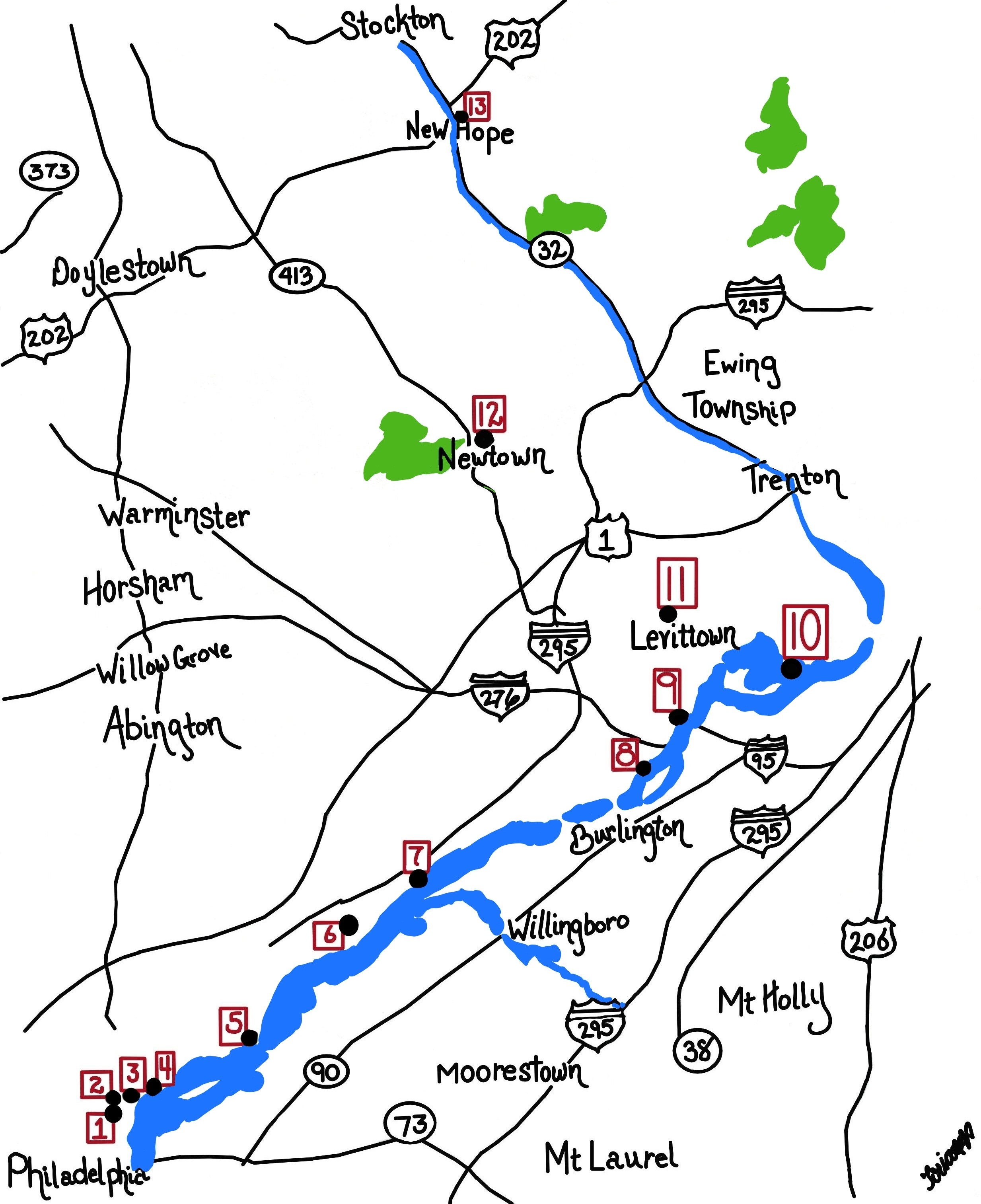
Montgomery and Bucks Counties
The Philadelphia metropolitan region has five Pennsylvania counties, four New Jersey counties, one northern county in the state of Delaware. Here are the four Pennsylvania suburban ones.
Robert Morris: The Dark Side
The richest man in America suddenly was locked in debtor's prison, $12 million in debt. While in prison, he reduced that to $3 million, and got released under a new bankruptcy law he helped devise.
The Pennamite Wars
The Connecticut farmers believed the King's last word overturned all earlier ones, else why be a king? William Penn's revolutionary idea was that of private property -- the first sale created a new owner, whose new word erased any earlier ones. When you acquire a new continent from aborigines, that's a congenial viewpoint.
Pennsylvania's First Industrial Revolution
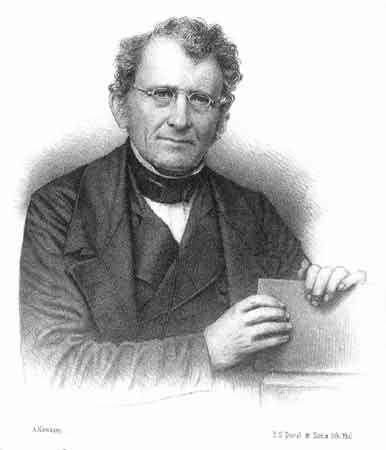
|
| David Thomas |
We tend to think of 1776 as the beginning of American history, but in fact, the region around Easton was settled a hundred-forty years before 1776, and the forests were pretty well lumbered out. The backwoods lumbermen around the junction of the Lehigh and Delaware Rivers were about to move further west when Washington crossed Delaware and fought the battle of Trenton. This region nevertheless had three essential ingredients for becoming the "Arsenal of the Revolution": It was close to the war zone but protected by mountains, it had a network of rivers, and it had coal. The hard coal of Anthracite had the problem it was slow to catch fire, and iron making in the region didn't really get started big-time until a Welsh iron maker named David Thomas discovered that anthracite for iron making would work if the air blast was pre-heated before introducing it into a "blast" furnace. A local iron maker traveled to England to license the patent from Thomas, whereupon Thomas' wife persuaded her husband to move to Pennsylvania. Blast furnaces only got started into production by 1840, but by 1870 there were 55 furnaces along the Lehigh Canal. For thirty years this was America's greatest iron-producing region. In fact, Bethlehem Steel only closed its last plant in 1995.
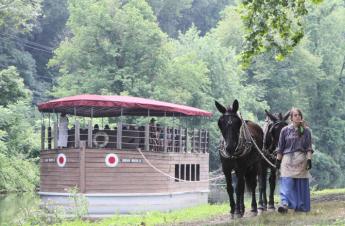
|
| Canal Boat |
When iron-making got started, the local industrial revolution really took off, but the more fundamental step was to dig canals to transport the coal to other regions. Canals were the dominant form of transportation for only thirty years until railroads took over, and the entire Northeast of the nation was laced with canals. Curiously, the South had relatively few canals, so their industrialization was too late for canals, and too early for railroads, to help much in the Civil War. The Erie Canal was the big winner, but Pennsylvania had many networks of canals in competition, leading to the Ohio and Mississippi Rivers, whereas the Erie Canal was more headed toward the Great Lakes and Chicago. Eventually, J.P. Morgan put an end to this race by financing the Pennsylvania Railroad and moving the steel industry to Pittsburgh, where bituminous coal was the fuel of choice. This industrial rivalry was at the heart of the enduring rivalry of Philadelphia and Pittsburgh, as well as the commercial rivalry between New York and Philadelphia. It was more or less the end of the flourishing economy of the "Reach" including Easton, Bethlehem, and Allentown. A reach is a geographic unit sort of bigger than a county, in local parlance. But you might as well include the city of Reading, which concentrated more on railroads and commerce with the Dutch Country. Out of danger from the British Fleet on the ocean, but close enough for war, the "reach" was more or less the forerunner of the Ho Chi Minh Trail in Vietnam in several later wars. The Lehigh Canal stretched from Easton to Mauch Chunk (now Jim Thorpe), the so-called Switzerland of Pennsylvania, only a mile or two West of the Northeast Extension of the Pennsylvania Turnpike.
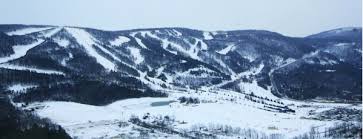
|
| Blue Mountain |
The Allegheny Mountains stretch across the State of Pennsylvania, and the most easterly of these mountains is locally called "Blue" mountain because of its hazy appearance from the East when seen across a lush and prosperous coastal plain. It represents the farthest extent of the several glaciers in the region, and the two sides of it present quite a sociological contrast. The Pennsylvania Dutch found themselves on the richest farming land in the world, whereas the inhabitants of the other side of the mountain had to subsist on pebbles. The mountain levels down at the Delaware River, so the Dutch farmers and the late immigrants from Central Europe mixed, in the time and region of industrial prosperity. Gradually, the miners and the steelworkers began to drift away, but the Pennsylvania Germans tended to remain where they had been before all the fuss. So the Kutztown Fair is full of Seven Sweets and Seven Sours, the farmhouses are large and ample, and mostly remain the way they were, too. You have little trouble finding a twang of Pennsylvania Dutch accents. But Bucks County in Pennsylvania was cut in half by the glacier, and north of the borderline, you can see lots of pickup trucks with gun racks behind the driver. Everything is amicable, you understand, but for some reason, the tax revenues of the two halves of the County are forbidden to be transferred, even within the same county. Better that way.
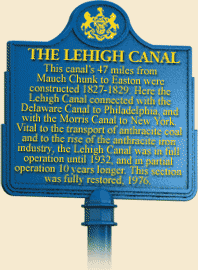
|
| Lehigh Marker |
The Lehigh River runs along the North side of Blue Mountain, and trickles down to join the Delaware at the town of Easton. There were only 11 houses in the town in 1776, and now you can see several miles of formerly elegant early Nineteenth century townhouses. At the point where the two rivers join, a lovely little park has been built to celebrate the high point of Colonial canal-making. Hugh Moore, the founder of the Dixie Cup Company is responsible for this historic memory, well worth a trip to see. If you have called ahead for reservations, you can have a genuine canal boat ride, pulled by two genuine mules. When you hear that the boat captain and his family used to live on the boat (Poppa steered, Momma, cooked, and the children tended the mules), it seems small and cramped. But when you climb aboard, you find it holds a hundred people for dinner with plates in their laps. The food is partly Polish, partly Hungarian and partly other things Central European. And the captain plays guitar and fiddle, singing old songs he mostly composed himself. Surprisingly, no Stephen Foster, who held forth about four hundred miles to the West, until he drank himself to death at Bellevue Hospital in New York. Foster was a member of a rival tribe of canal boaters, the ones who traveled down to Pittsburgh via the Erie Canal. Along the Reach, you hear about three canals, the Lehigh, Delaware, and Morris. The first two are obvious enough since they and the railroads which subsequently followed ran along the banks of two rivers joined. The Morris was Robert Morris, at one time the richest man in America, who bought Morrisville across from Trenton on the speculation he could persuade his friends to put the Nation's Capital there. It didn't work out, so he bought and went broke with the District of Columbia. Anyway, the Morris canal went on to New York harbor, where it prospered mightily shipping iron to New York, and iron for the rolling mills of Boston. The Morris Canal went over the Delaware River on a bridge that carried an aqueduct, over to Philipsburg; and then across the wasp waist of New Jersey.
Originally published: Sunday, October 05, 2014; most-recently modified: Tuesday, April 30, 2019